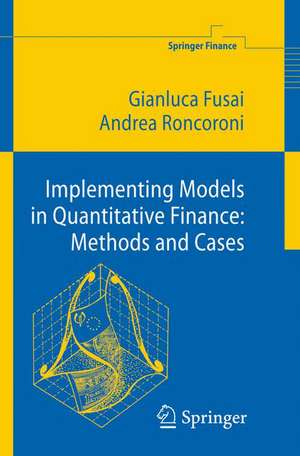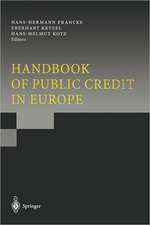Implementing Models in Quantitative Finance: Methods and Cases: Springer Finance
Autor Gianluca Fusai, Andrea Roncoronien Limba Engleză Hardback – 17 ian 2008
| Toate formatele și edițiile | Preț | Express |
|---|---|---|
| Paperback (1) | 588.70 lei 38-44 zile | |
| Springer Berlin, Heidelberg – 12 feb 2010 | 588.70 lei 38-44 zile | |
| Hardback (1) | 801.17 lei 43-57 zile | |
| Springer Berlin, Heidelberg – 17 ian 2008 | 801.17 lei 43-57 zile |
Din seria Springer Finance
- 13%
 Preț: 359.67 lei
Preț: 359.67 lei - 24%
 Preț: 703.47 lei
Preț: 703.47 lei - 18%
 Preț: 787.15 lei
Preț: 787.15 lei - 19%
 Preț: 501.62 lei
Preț: 501.62 lei - 24%
 Preț: 809.77 lei
Preț: 809.77 lei - 17%
 Preț: 361.15 lei
Preț: 361.15 lei - 24%
 Preț: 605.30 lei
Preț: 605.30 lei - 17%
 Preț: 398.82 lei
Preț: 398.82 lei - 15%
 Preț: 649.06 lei
Preț: 649.06 lei - 18%
 Preț: 937.37 lei
Preț: 937.37 lei - 15%
 Preț: 659.85 lei
Preț: 659.85 lei -
 Preț: 387.75 lei
Preț: 387.75 lei - 18%
 Preț: 1108.36 lei
Preț: 1108.36 lei - 15%
 Preț: 651.19 lei
Preț: 651.19 lei - 15%
 Preț: 658.88 lei
Preț: 658.88 lei - 18%
 Preț: 1112.60 lei
Preț: 1112.60 lei - 18%
 Preț: 937.86 lei
Preț: 937.86 lei -
 Preț: 418.34 lei
Preț: 418.34 lei -
 Preț: 398.15 lei
Preț: 398.15 lei - 15%
 Preț: 597.01 lei
Preț: 597.01 lei - 15%
 Preț: 637.89 lei
Preț: 637.89 lei - 18%
 Preț: 939.62 lei
Preț: 939.62 lei - 15%
 Preț: 632.19 lei
Preț: 632.19 lei - 18%
 Preț: 737.26 lei
Preț: 737.26 lei -
 Preț: 385.84 lei
Preț: 385.84 lei - 18%
 Preț: 892.90 lei
Preț: 892.90 lei -
 Preț: 395.25 lei
Preț: 395.25 lei - 15%
 Preț: 497.45 lei
Preț: 497.45 lei - 15%
 Preț: 644.95 lei
Preț: 644.95 lei - 18%
 Preț: 1207.45 lei
Preț: 1207.45 lei - 18%
 Preț: 810.81 lei
Preț: 810.81 lei -
 Preț: 391.61 lei
Preț: 391.61 lei - 19%
 Preț: 506.25 lei
Preț: 506.25 lei - 18%
 Preț: 957.62 lei
Preț: 957.62 lei -
 Preț: 387.75 lei
Preț: 387.75 lei - 15%
 Preț: 503.37 lei
Preț: 503.37 lei - 15%
 Preț: 593.91 lei
Preț: 593.91 lei -
 Preț: 383.71 lei
Preț: 383.71 lei
Preț: 801.17 lei
Preț vechi: 977.04 lei
-18% Nou
Puncte Express: 1202
Preț estimativ în valută:
153.30€ • 160.49$ • 126.85£
153.30€ • 160.49$ • 126.85£
Carte tipărită la comandă
Livrare economică 07-21 aprilie
Preluare comenzi: 021 569.72.76
Specificații
ISBN-13: 9783540223481
ISBN-10: 3540223487
Pagini: 632
Ilustrații: XXIII, 607 p.
Dimensiuni: 155 x 235 x 44 mm
Greutate: 0.99 kg
Ediția:2008
Editura: Springer Berlin, Heidelberg
Colecția Springer
Seria Springer Finance
Locul publicării:Berlin, Heidelberg, Germany
ISBN-10: 3540223487
Pagini: 632
Ilustrații: XXIII, 607 p.
Dimensiuni: 155 x 235 x 44 mm
Greutate: 0.99 kg
Ediția:2008
Editura: Springer Berlin, Heidelberg
Colecția Springer
Seria Springer Finance
Locul publicării:Berlin, Heidelberg, Germany
Public țintă
ResearchCuprins
Methods.- Static Monte Carlo.- Dynamic Monte Carlo.- Dynamic Programming for Stochastic Optimization.- Finite Difference Methods.- Numerical Solution of Linear Systems.- Quadrature Methods.- The Laplace Transform.- Structuring Dependence using Copula Functions.- Problems.- Portfolio Selection: “Optimizing” an Error.- Alpha, Beta and Beyond.- Automatic Trading: Winning or Losing in a kBit.- Estimating the Risk-Neutral Density.- An “American” Monte Carlo.- Fixing Volatile Volatility.- An Average Problem.- Quasi-Monte Carlo: An Asian Bet.- Lookback Options: A Discrete Problem.- Electrifying the Price of Power.- A Sparkling Option.- Swinging on a Tree.- Floating Mortgages.- Basket Default Swaps.- Scenario Simulation Using Principal Components.- Parametric Estimation of Jump-Diffusions.- Nonparametric Estimation of Jump-Diffusions.- A Smiling GARCH.
Recenzii
From the reviews:
"As the title suggests the book is divided into two parts. … The style of the book is very inviting and it should be on the shelf of every serious researcher and practitioner in quantitative finance, including graduate students. Teachers could easily use the book in their applied courses. Overall, I think the book is a clear self-contained guide to implementing models in quantitative finance and as such it is going to be very popular in quant and academic circles." (Ita Cirovic Donev, MathDL, July, 2008)
"This application-oriented book presents the major numerical methods currently used and describes how these methods can be used to solve problems in quantitative finance. … Each chapter includes exercises for student practice … . The presentation is at an intermediate-advanced level and serves as an introductory tutorial to the field of quantitative finance. Quantitative analysts, researchers and graduate students in quantitative finance will find this book useful." (Stefan Henn, Mathematical Reviews, Issue 2009 g)
"As the title suggests the book is divided into two parts. … The style of the book is very inviting and it should be on the shelf of every serious researcher and practitioner in quantitative finance, including graduate students. Teachers could easily use the book in their applied courses. Overall, I think the book is a clear self-contained guide to implementing models in quantitative finance and as such it is going to be very popular in quant and academic circles." (Ita Cirovic Donev, MathDL, July, 2008)
"This application-oriented book presents the major numerical methods currently used and describes how these methods can be used to solve problems in quantitative finance. … Each chapter includes exercises for student practice … . The presentation is at an intermediate-advanced level and serves as an introductory tutorial to the field of quantitative finance. Quantitative analysts, researchers and graduate students in quantitative finance will find this book useful." (Stefan Henn, Mathematical Reviews, Issue 2009 g)
Notă biografică
Gianluca Fusai is Associate Professor in Financial Calculus at Università degli Studi del Piemonte Orientale (Italy) and a Research Associate at Financial Options Research Center, Univeristy of Warwick. He holds a Ph.D in Finance from the Warwick Business School and a MS in Statistics and Operational Research from University of Essex, UK. His research interest are Financial Engineering, Numerical Methods, Portfolio Selection, and Financial Statistics. On this topics he has published in journals like Journal of Computational Finance, Risk, Annals of Applied Probability, International Journal of Theoretical and Applied Finance. He has worked as a consultant in the private sector (Mediolanum Assicurazioni, Selenia Luxco, Nike Consulting, Software Company, Equitable House).
Andrea Roncoroni is Associate Professor of Finance at ESSEC Business School (Paris-Singapore), Senior Lecturer at Bocconi University (Milan), and Co-director of the Master in Energy Finance at MIP - Politecnico di Milano. He holds PhDs in Applied Mathematics and in Finance. His research interests cover Energy and Commodity Finance, Financial Modeling, Risk Management and Derivative Structuring. He consults for private companies and lectures for private and public institutions (International Energy Agency, Italian Stock Exchange, Italian Energy Authority, Italian Power Exchange, University Paris Dauphine, University of Oslo). He regularly publishes in academic journals (J.of Business, J.of Banking and Finance, Intl.J.of Business).
Andrea Roncoroni is Associate Professor of Finance at ESSEC Business School (Paris-Singapore), Senior Lecturer at Bocconi University (Milan), and Co-director of the Master in Energy Finance at MIP - Politecnico di Milano. He holds PhDs in Applied Mathematics and in Finance. His research interests cover Energy and Commodity Finance, Financial Modeling, Risk Management and Derivative Structuring. He consults for private companies and lectures for private and public institutions (International Energy Agency, Italian Stock Exchange, Italian Energy Authority, Italian Power Exchange, University Paris Dauphine, University of Oslo). He regularly publishes in academic journals (J.of Business, J.of Banking and Finance, Intl.J.of Business).
Textul de pe ultima copertă
This book puts numerical methods into action for the purpose of solving concrete problems arising in quantitative finance. Part one develops a comprehensive toolkit including Monte Carlo simulation, numerical schemes for partial differential equations, stochastic optimization in discrete time, copula functions, transform-based methods and quadrature techniques. The content originates from class notes written for courses on numerical methods for finance and exotic derivative pricing held by the authors at Bocconi University since the year 2000. Part two proposes eighteen self-contained cases covering model simulation, derivative valuation, dynamic hedging, portfolio selection, risk management, statistical estimation and model calibration. It encompasses a wide variety of problems arising in markets for equity, interest rates, credit risk, energy and exotic derivatives. Each case introduces a problem, develops a detailed solution and illustrates empirical results. Proposed algorithmsare implemented using either Matlab® or Visual Basic for Applications® in collaboration with contributors.
Caracteristici
Fills a gap in the current published literature by delivering a case-study collection together with a self-contained course on major numerical methods developed and used by the finance industry Learning-by-doing approach: all steps detailed in a self-contained way Covers a range of numerical methods Blends theoretical presentation and practical implementations Originality in the choice of cases Provides detailed algorithm and the corresponding code Includes supplementary material: sn.pub/extras



















